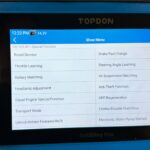The 1997 Honda Odyssey, like many vehicles of its era, utilizes the OBD-II (On-Board Diagnostics II) protocol. This system is crucial for monitoring your vehicle’s emissions and overall engine health. If you’ve recently faced issues with your Honda Odyssey failing an emissions test due to “readiness monitors not ready,” understanding the OBD-II drive cycle can be invaluable. This guide will explain the OBD-II protocol in the context of your 1997 Honda Odyssey and detail the specific drive cycle procedure to help reset these monitors, potentially saving you time and money.
Decoding the OBD-II Protocol for Your 1997 Honda Odyssey
The OBD-II system is standardized across most vehicles sold in the United States from 1996 onwards. For your 1997 Honda Odyssey, this means a standardized diagnostic port, typically located under the dashboard, allows access to a wealth of information about your vehicle’s performance. This protocol is designed to:
- Monitor Emissions: The primary function is to ensure your vehicle meets stringent emissions standards. Sensors throughout the engine and exhaust system constantly monitor components like the catalytic converter, oxygen sensors, and EVAP system.
- Detect Malfunctions: When the OBD-II system detects a problem that could affect emissions, it stores a Diagnostic Trouble Code (DTC) and often illuminates the “Check Engine Light” on your dashboard.
- Readiness Monitors: These are system checks that the OBD-II performs to ensure all emissions-related systems are functioning correctly. Monitors can be in a “ready” or “not ready” state. When monitors are “not ready,” it often means the vehicle has recently had its battery disconnected or computer system reset, and the car hasn’t completed the necessary driving conditions to run all diagnostic tests. This is a common reason for failing smog checks.
Understanding that your 1997 Honda Odyssey uses this OBD-II protocol is the first step in addressing emissions readiness issues. The drive cycle is specifically designed to run these monitors.
Performing the OBD-II Drive Cycle on Your 1997 Honda Odyssey
The OBD-II drive cycle is a specific set of driving conditions that, when followed correctly, will allow your 1997 Honda Odyssey to run all of its onboard diagnostic tests and set the readiness monitors to “ready.” It’s crucial to start this process with a “cold start.” This means the engine coolant temperature must be below 122 degrees Fahrenheit (50 degrees Celsius) and the air and coolant temperature sensors should be within 11 degrees Fahrenheit (6 degrees Celsius) of each other. Importantly, do not turn the ignition key to the “ON” position before the cold start, as this can prevent the heated oxygen sensor diagnostic from running correctly.
Here are the steps for the OBD-II drive cycle for your 1997 Honda Odyssey:
-
Cold Start and Idle: Start the engine and let it idle in drive for two and a half minutes. Ensure the air conditioning (A/C) and rear defroster are turned ON. During this phase, the OBD-II system checks the oxygen sensor heater circuits, air pump (if equipped), and EVAP purge system.
-
Acceleration and Steady Speed: Turn the A/C and rear defroster OFF. Accelerate smoothly to 55 mph (88 km/h) using approximately half throttle. Once at 55 mph, maintain a steady speed for three minutes. This step allows the OBD-II system to check for ignition misfires, fuel trim, and canister purge. It also monitors the EGR (Exhaust Gas Recirculation) system, air pump, O2 sensors, and canister purge.
-
Deceleration: Without braking or depressing the clutch (simply let off the accelerator pedal), decelerate (coast down) to 20 mph (32 km/h). This allows the OBD-II system to check the EGR and purge functions.
-
Re-acceleration and Steady Speed: Accelerate again to 55 to 60 mph (88-96 km/h) using approximately half throttle. Maintain a steady speed within this range for five minutes. During this extended steady speed period, the OBD-II system monitors catalytic converter efficiency, misfires, EGR, fuel trim, oxygen sensors, and purge functions.
-
Final Deceleration and Stop: Decelerate (coast down) to a complete stop without using the brakes. During this final deceleration, the OBD-II system performs a last check of the EGR and canister purge systems.
Why This Drive Cycle Is Important for Your 1997 Honda Odyssey
Successfully completing the OBD-II drive cycle is essential for ensuring your 1997 Honda Odyssey passes an emissions or smog test. If your readiness monitors are not set, the testing station will likely fail your vehicle, even if there are no active emission problems. By performing this drive cycle, you are giving your vehicle the opportunity to run all necessary diagnostic checks.
Important Considerations:
- Safety First: Perform the drive cycle in a safe location where you can legally and safely reach and maintain the specified speeds.
- No Check Engine Light: Ideally, you should perform the drive cycle with no “Check Engine Light” illuminated. If the light is on, there is an existing problem that needs to be addressed before the readiness monitors can reliably set.
- Scan Tool: Using an OBD-II scan tool, such as those offered by Autel, can significantly aid this process. A scan tool allows you to:
- Verify Readiness Monitor Status: Check which monitors are ready or not ready before, during, and after the drive cycle.
- Clear Codes (if necessary): If you’ve addressed a minor issue and need to clear codes to start fresh, a scan tool can do this.
- Monitor Live Data: Some scan tools allow you to monitor live engine parameters during the drive cycle, giving you more insight into the process.
By understanding the OBD-II protocol and performing the correct drive cycle for your 1997 Honda Odyssey, you can proactively address readiness monitor issues and ensure your vehicle is ready for emissions testing. Utilizing diagnostic tools can further streamline this process and provide valuable insights into your vehicle’s health.

